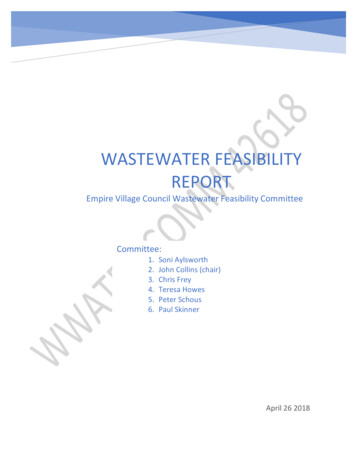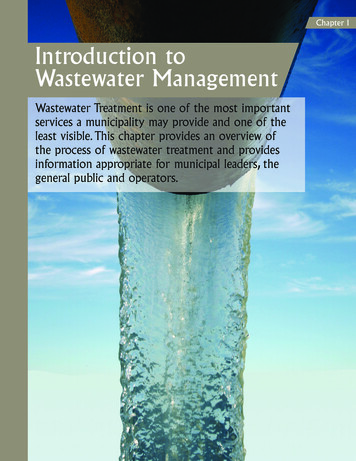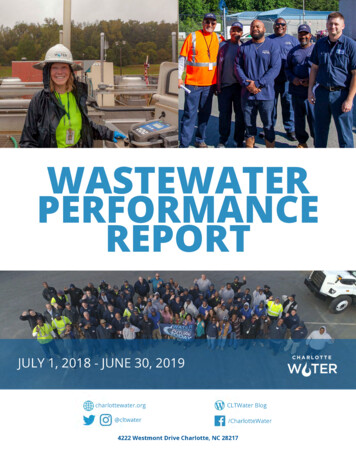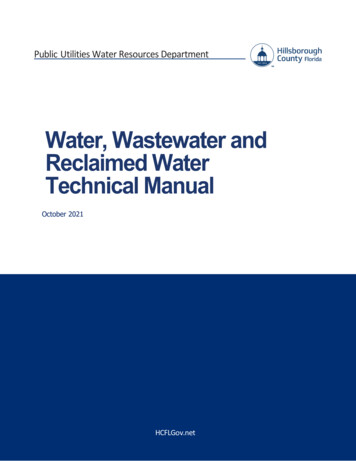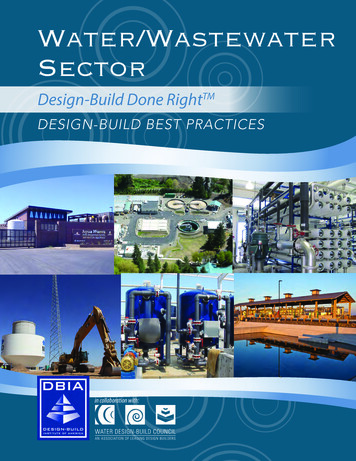
Transcription
Water/WastewaterSectorDesign-Build Done RightTMDESIGN-BUILD BEST PRACTICESin collaboration with:DESIGN-BUILD DONE RIGHT 1December 2015
WATER/WASTEWATER SECTORDESIGN-BUILD BEST PRACTICESDesign-Build Done RightTMA DESIGN-BUILD INSTITUTE OF AMERICA PUBLICATIONThe information contained in this document is intended for use with Design-Build Done Right: Universally Applicable Design-Build Best Practices(hereafter referred to as “Universal Best Practices”) published by the Design-Build Institute of America in February 2014. For a copy of thisdocument, visit http://www.dbia.org and go to the “Resources” section.Like DBIA’s Universal Best Practices, this document includes three primary sections:(I) Procuring Design-Build Services;(II) Contracting for Design-Build Services; and(III) Executing the Delivery of Design-Build Projects.Within each of these three sections, you will find the Universal Best Practices and implementing techniques as a baseline. Thebaseline is then modified in two ways:(I) Some slight modifications to the universal implementing techniques.(II) New implementing techniques, all of which are intended to address the real-world attributes of the water/wastewatersector.The modifications are shown in this bold blue font to help readers easily see the changes.This document, which combines Universal Best Practices with water/wastewater best practices and implementing techniques, is the basis forDesign-Build Done RightTM in the water/wastewater sector.COVER PHOTO CREDITSTop Row, Left to Right:Agua Nueva Water Reclamation Facility, Owner: Pima County Regional Wastewater Reclamation Department, 2014 National Design-Build Merit Award Winner;Wilsonville Wastewater Treatment Plant Improvements Project, Owner: City of Wilsonville, 2014 National Design-Build Merit Award Winner; 2.0-MGDNanofiltration Water Treatment Plant Addition, Owner: City of Dania Beach, 2013 National Design-Build Award WinnerBottom Row, Left to Right:T-Bar Well Field Development and Delivery Project, Owner: Midland County Fresh Water Supply District No. 1, 2013 National Design-Build Merit AwardWinner; Johnson Controls Florence Recycling Center Stormwater and Wastewater Treatment Facility, Owner: Johnson Controls, Inc., 2013 National DesignBuild Award Winner; Stockton Delta Water Supply Project, Owner: City of Stockton, 2013 National Design-Build Merit Award Winner2 DESIGN-BUILD DONE RIGHTDecember 2015
WHAT’S UNIQUE ABOUT THE WATER/WASTEWATER SECTOR?The water/wastewater sector has five unique features that are central to the consideration of best practices in the procurement, contracting andexecution of any design-build project.First, the characteristics of a water/wastewater owner are substantially different from other public owners. Most water and wastewater projectsare implemented on the local level, either by cities, counties or quasi-governmental utilities. As a result, the design-build procurement authorityfor these owners can be quite complex and affected by state statutes, local ordinances and/or procurement authority created by the utility’sboard of directors. Adding to the challenge is that many water/wastewater owners have limited capital programs and rely heavily on outsideadvisors for project development assistance. On the other hand, these owners have significant expertise in plant and systems operations, andhave strong views of what technology and process equipment they want to use on their facilities.Second, the characteristics of a water/wastewater project are quite different from those in other public sectors. Whether small or large, theseprojects are anything but “cookie cutter” in nature. Projects involving upgrades and/or expansions to aging facilities create challenges regardinghow to ensure uninterrupted operation of the facility during construction and integration of new technology and processes into existing plantsystems. Greenfield projects generally give owners a wide choice of technology, requiring them to make timely decisions on what to use.And, perhaps most importantly, the raw water/wastewater quality of each project is different. While this creates substantial opportunity forinnovation, it also creates execution risks, particularly relative to regulatory permitting, start-up & commissioning and acceptance testing.Third, the organizational structure of a design-build team for the execution of a water/wastewater project is typically different than in otherpublic sectors. Generally speaking, the design-builder for most transportation and building projects is led by a contractor, with the lead designprofessional serving as a sub-consultant. In the water/wastewater sector, it is common to find a fully integrated design-build firm in the lead,managing the construction through subcontracting with or without some amount of construction self-performance. It is also common to seethe design-builder as a joint venture between a general contractor and either an engineering firm or the construction subsidiary/affiliate ofan engineering firm. These joint venture approaches can create some major opportunities in terms of how design-build can best be used indelivering a project.The three preceding points have resulted in the fourth major difference between how design-build is executed in the water/wastewater sectorversus other public sector design-build projects.Fourth, if they have the procurement authority to do so, many water/wastewater owners bring the design-builder to the project very early inthe design process. They do this through a qualifications-driven procurement process that selects the design-builder to work in collaborationwith the owner to define the scope and its quality, budget and schedule and to execute the project, all as approved by the owner. This process,which has come to be known as “Progressive Design-Build,” provides a stark contrast to “Bridging Design-Build,” which has been the normfor other public sector and federal agency design-build projects. Readers should note that while the term “Bridging Design-Build” is a DBIArecognized term used in other public sectors, it has not been typically used in water/wastewater sector. Instead, the term “Fixed Price DesignBuild” has become the commonly used term in this sector and it is used in this publication.Procurements for Fixed Price Design-Build are based on either a prescriptive approach or a purely performance-based approach. In each case:(a) owners and their design consultants develop detailed documentation that define the project’s technical requirements; and (b) proposersprovide technical proposals based upon this documentation, and price is often the major factor in deciding upon which proposer will be selectedas the design-builder. Under either approach, the owner will make a major time and money commitment because of the need to advancedocumentation. It should also be noted that potential design-builders carefully evaluate the return on investment of their marketing dollarswhen evaluating whether to pursue a Fixed Price Design-Build procurement, given that price is a major factor in selection.The prescriptive approach enables the owner to control the design, as the RFP’s documentation will contain a detailed design. This control comesat a cost, as the design-builder’s ability to offer innovative and cost-effective design solutions is severely constrained. It may also create thepotential for conflicts between the owner and design-builder over who should bear the financial risk of mistakes in the documentation providedDESIGN-BUILD DONE RIGHT 3December 2015
to proposers that are discovered after contract award. A performance-based approach will identify performance requirements in the RFP, withfew (if any) prescriptive design elements. Proposers are challenged to propose the best technical solution at the lowest cost (e.g., life-cycle costor net present value). While performance-based procurements allow design-builders to innovate and develop cost-effective design solutions,the owner may find that the design-builder’s design solution does not meet its preference (although the design meets the owner’s performancerequirements). Performance-based procurements are typically limited to owners who do not seek to have a clear definition of the project whenthey are starting the procurement, and may best be used when technical solutions require innovative thinking or implementing emergingtechnology in the final project solution.Progressive Design-Build works much differently. Its overall objective is to have the design-builder collaborate with the owner and its team ofin-house personnel and outside advisors to develop the basis of design. Another distinct characteristic of Progressive Design-Build is to have theoverall project price negotiated once the design is developed to a point where the project and scope of work are well-defined. To accomplishthis, the owner will procure the design-builder either fully or primarily based on team and individual qualifications. If any price-related factorsare considered (e.g., compensation for preliminary design services and/or design-builder fee), they carry a low weighting.Owners can see specific benefits when they introduce the design-builder to the project early and have it participate with the owner in thedesign process. This leads, among other things, to optimum life-cycle costing, equipment selection and even the selection of key tradesubcontractors. These benefits are generally not available when an owner uses Fixed Price Design-Build. Moreover, the collaborative designdevelopment process also has the benefit of enabling design decisions to be made in an open-book cost environment, giving the owner realtime information that can better inform it of design-price tradeoffs. Lastly, this approach enables the owner to decide the optimal point atwhich to obtain a price proposal from the design-builder. Price proposals are typically obtained at some point between 50% and 90% of theoverall design completion and are typically based on a guaranteed maximum price (GMP). A GMP is a cost plus fee arrangement where cost andfee are defined. Some owners as this point choose to convert the GMP into a lump sum (i.e., fixed price).Fifth and lastly, in the water and wastewater sector it is common to see the term alternative project delivery include construction managementat risk (CMAR), Fixed Price Design-Build (FP DB) and Progressive Design-Build (PDB). In the water and wastewater sector these forms of projectdelivery have become widely used and accepted and as such should not be considered “alternative” any longer. Moving forward the moreappropriate term, collaborative project delivery, will be used.DESIGN-BUILD DONE RIGHT IN THEWATER/WASTEWATER SECTORIn February 2014, DBIA released Design-Build Done Right: Universally Applicable Design-Build Best Practices. This publication identified practicesthat had two basic characteristics: (1) they were written to be universal in applicability, spanning any type of design-build project; and (2) theywere important enough to directly affect project performance. Stated differently, implementing the Universal Best Practices on any type ofdesign-build project increases the probability of a successful project that meets the expectations of all stakeholders. If these practices are notimplemented, there is an increased probability that the project’s performance will be compromised and that some or all of the stakeholders willbe disappointed.Design-Build Done Right: Universally Applicable Design-Build Best Practices was organized into three primary sections:i.ii.iii.Procuring Design-Build ServicesContracting for Design-Build ServicesExecuting the Delivery of Design-Build ProjectsEach section of that publication contains overarching principles that represent the best practice. Each best practice is then supplemented byseveral implementing techniques that provide guidance on specific ways to implement the best practice – essentially “mini best practices.”The combination of best practices and implementing techniques are the basis for Design-Build Done Right .DBIA’s Universally Applicable Design-Build Best Practices publication recognizes that there are real-world differences among design-build market4 DESIGN-BUILD DONE RIGHTDecember 2015
sectors (e.g., water/wastewater, transportation, federal projects) and that specific implementation techniques might differ slightly from onemarket sector to another. This publication uses the Universal Best Practices as a baseline. The baseline is modified in two ways: (a) in a fewinstances by slight modifications to the universal implementation techniques; and (b) new implementing techniques, all of which are intendedto address the real-world attributes of the water/wastewater sector – particularly relative to the four issues addressed in the preceding section.These modifications are shown in a blue font to help readers easily see the changes. DBIA also recognizes that some owners and practitionersmay want further explanation and guidance to fully appreciate the thought behind the principles in this document. Therefore, it is anticipatedthat from time-to-time additional publications will be provided to elaborate on these principles.DBIA intends to continually update its portfolio of publications, tools and other resources so that design-build stakeholders will have access toleading-edge information that will allow them to do design-build “right” in accordance with the concepts expressed in this document.I. Procuring Design-Build ServicesAn owner’s choices of project delivery system and procurement approach strongly influence project results. These choices are among the firstdecisions an owner makes on a project and they form the foundation for how the project will be developed, procured and executed, and how thekey project stakeholders communicate and relate to each other. In making these choices, it is critical for an owner to consider the particulars andcircumstances of each project, including the procurement options available to the owner. After thoroughly considering these issues, an owner shouldmake a strategic decision as to how to take full advantage of the many benefits that are inherent in the design-build process.DBIA considers the following as three (3) best practices for owners as they make their project delivery and procurement decisions.1.An owner should conduct a proactive and objective assessment of the unique characteristicsof its program/project and its organization before deciding to use design-build.In furtherance of this practice, the following implementing techniques apply:a. Owners should understand the potential benefits, limitations and attributes of design-build and make an informed decision as towhether the use of design-build will benefit their program/project.b. Owners should create an organization that supports the successful procurement and execution of a design-build project, with keypersonnel (including those advising/representing the owner) educated and trained in, among other things: (a) the procurement,contracting and execution of design-build projects; and (b) the importance of setting expectations and fostering a collaborativerelationship among all members of the project team.c. Owners should identify and involve key project stakeholders at the early stages of project planning, as stakeholder goals,expectations, challenges, constraints and priorities should guide all project planning and procurement activities, including thedetermination and implementation of design excellence and sustainability goals.d. Owners should involve senior leadership that is committed to the success of the design-build process, as this will foster a healthyand trusting relationship among the entire project team.e. Owners should carefully research and assess current market conditions as they plan their design-build programs, as this willidentify potential risks and opportunities. Among the issues to be researched and assessed include: (a) procurement actionsthat could limit or expand competition; (b) projected labor, material and equipment availability; (c) lessons learned from similarprojects; and (d) realism of budget and schedule estimates.f. Owners should use a rigorous and equitably-balanced project risk assessment process early in the procurement process andupdate/refine the risk assessment as the project proceeds from procurement through project execution.DESIGN-BUILD DONE RIGHT 5December 2015
I. Procuring Design-Build Services (Cont.)g. Owners should understand all procurement constraints imposed or flexibilities afforded by their legislative, regulatory or internalrequirements.h. Owners should make an early determination of their programmatic position on conflicts-of-interest policy for design-buildprocurements and promptly disclose this policy to the marketplace that will likely pursue these design-build procurements.i. Owners should make an early determination about their expectations for the design-builder’s role in the start-up, commissioningand operations of the project and reflect expectations in their procurement approach.j. Owners should specifically recognize the importance of their procurement, legal and operations and maintenancedepartments in successfully procuring and executing capital projects and develop processes to educate and seekinput from key personnel in those departments, particularly if the departments are unfamiliar with design-buildand other collaborative project delivery approaches.k. Owners should determine, as part of its consideration of delivery system alternatives, who will manage andbe responsible for the environmental permitting process, geotechnical investigations and permanent utilitiesconnections.2.An owner should implement a procurement plan that enhances collaboration and otherbenefits of design-build and is in harmony with the reasons that the owner chose the design-build delivery system.In furtherance of this practice, the following implementing techniques apply:a. Owners should use a procurement process that: (a) focuses heavily on the qualifications of the design-builder and its key teammembers rather than price; and (b) rewards design-build teams that have a demonstrated history of successfully collaborating ondesign-build projects.b. Owners should use a procurement process that encourages the early participation of key trade contractors and professionalservices consultants.c. Owners should develop their design-build procurement with the goal of minimizing the use of prescriptive requirements andmaximizing the use of performance-based requirements, which will allow the design-build team to meet or exceed the owner’sneeds through innovation and creativity.d. Owners should develop realistic project budgets, and provide clarity in their procurement documents about their budgets,including, as applicable: (a) identifying “hard” contract cost/budget ceilings; (b) stating whether target budgets can be exceeded ifproposed solutions enhance overall value; and (c) stating whether the owner expects proposers to develop technical proposals thatwill encompass the entire target budget.e. Owners should consider the level of effort required by proposers to develop responsive proposals, and should limit the deliverablessought from proposers to only those needed to differentiate among proposers during the selection process.f. Owners who require project-specific technical submittals (e.g., preliminary designs) for evaluating and selecting the design-buildershould: (a) use a two-phase procurement process; and (b) limit the requirement for such submittals to the second phase, where thelist of proposers has been reduced.6 DESIGN-BUILD DONE RIGHTDecember 2015
I. Procuring Design-Build Services (Cont.)g. Owners should determine, as part of their procurement plan, their position on: (a) the use of a stipend forunsuccessful proposers; and (b) contract security requirements (i.e. bonds, insurance and corporate guarantees).h. Owners who intend to have the design-builder perform services that extend beyond completion of normalacceptance testing (e.g., extended start-up and commissioning, training, process optimization, operationand maintenance assistance, etc.) should make a thoughtful decision about the qualifications and experiencerequirements for the design-builder and whether it is necessary or appropriate to evaluate the proposers’ financialstatements on a weighted, vs. pass-fail basis, and this should be considered as part of the procurement plan, as itmay influence the formation of teams. Owners who seek short- or long-term operations and maintenance shouldconsider the design-build-operate project delivery method.i. Owners should objectively assess those areas within the owner’s organization that will be involved in the designbuild project, determine what, if anything, is needed to support the design-build project and promptly implementas-needed modifications to existing processes and staffing levels and expertise.j. Information requested by the owner during the procurement process should focus on being able to establish keydifferentiators among the proposers, and should be used in the evaluation process by being linked to specificevaluation criteria.k. Owners should: (a) provide historical data on quantity and quality of input and, if applicable, the past performanceand other existing information about existing facilities; and (b) make a thoughtful decision as to what informationthe design-builder can rely on in preparing a technical proposal (e.g., water quality analyses), particularly in thecase of Progressive Design-Build, where the design-builder will be paid for design-related services it performs aftercontract award.l. Owners who are considering using prescriptive technical requirements as part of their procurement process should,as part of their procurement plan, thoughtfully assess the impact of doing so on their overall project goals and thecommercial consequences if there are mistakes in those requirements.m. Owners who have the ability to consider Progressive Design-Build as an option for their projects should, as partof their procurement plans, make an early determination of what level of design should be performed by theowner and its consultants prior to initiating the procurement, as three of the major benefits of this process are:(a) enabling the design-builder to be involved in the early determination of design solutions; (b) maximizingthe opportunity for design-builder innovation during the design process; and (c) streamlining the design-buildprocurement process.n. Owners who select Progressive Design-Build should, as part of their procurement plan, provide specific training fortheir operations and maintenance personnel about the characteristics of the process and how such personnel will beinvolved during the procurement and implementation stages of the process.o. Owners should determine the requirements of freedom of information and other disclosure laws, and ensure thattheir procurement is conducted consistently with such laws.3.An owner using a competitive design-build procurement that seeks price and technicalproposals should: (a) establish clear evaluation and selection processes; (b) ensure thatthe process is fair, open and transparent; and (c) value both technical concepts and price inthe selection process. In furtherance of this practice:DESIGN-BUILD DONE RIGHT 7December 2015
I. Procuring Design-Build Services (Cont.)a. Owners should perform appropriate front-end tasks (e.g., geotechnical/environmental investigations and permit acquisitions)to enable the owner to: (a) develop a realistic understanding of the project’s scope and budget; and (b) furnish proposers withinformation that they can reasonably rely upon in establishing their price and other commercial decisions.b. Owners should appropriately shortlist the number of proposers invited to submit proposals, as this will, among other things,provide the best opportunity for obtaining high quality competition.c. Owners should provide shortlisted proposers with a draft design-build contract at the outset of the second phase of procurement,which: (a) provides proposers with an opportunity to suggest modifications during the proposal process; and (b) enables proposersto base their proposals on the final version of the contract.d. Owners should conduct confidential meetings with shortlisted proposers prior to the submission of technical and price proposals,as this encourages the open and candid exchange of concepts, concerns and ideas. However, because these confidentialmeetings can be costly and resource-intensive for all parties, limitations on the number of such meetings should beconsidered.e. Owners should protect the intellectual property of all proposers and should not disclose such information during the proposalprocess.f. Owners should offer a reasonable stipend to unsuccessful shortlisted proposers when the proposal preparation requires a significantlevel of effort.g. Owners should ensure that their technical and cost proposal evaluation team members are: (a) trained on the particulars of theprocurement process; (b) unbiased; and (c) undertake their reviews and evaluations in a manner consistent with the philosophyand methodology described in the procurement documents.h. Owners should ensure that technical review teams do not have access to financial/price proposals until after completion of thescoring of the technical proposals.i. Owners should provide unsuccessful proposers with an opportunity to participate in an informative debriefing session.j. Owners who use prescriptive documents for a Fixed Price Design-Build should: (a) determine whether applicable lawallows proposers to submit deviations from these prescriptive requirements through the submission of AlternativeTechnical Concepts (ATCs); (b) establish a clear process for the exchange and consideration of ATCs (e.g., confidentialmeetings) and how ATCs will be incorporated into the evaluation process; and (c) consider the level of effort and costrequired of the proposers in developing ATCs and, consequently, determine which areas of the bridging documentswill not be considered for ATCs and communicate those determinations in the procurement documents.k. Owners using a Progressive Design-Build process should: (a) if allowed by applicable law, select the design-builderbased on qualifications, experience and other non-price considerations; or, (b) if required by law to consider price,limit price factors to pricing components that are reasonably ascertainable by the proposer, such as compensationfor preliminary services and/or design-builder fee and make such price-based considerations a nominal weight inthe overall selection process.l. Owners who want to use the procurement process to obtain detailed technical proposals should consider using FixedPrice Design-Build with stipends rather than Progressive Design-Build, as this is not only costly for the proposers,but is not compatible with the goals and philosophy behind Progressive Design-Build.8 DESIGN-BUILD DONE RIGHTDecember 2015
I. Procuring Design-Build Services (Cont.)m. Owners should carefully consider the extent of technical information required in the submitted proposals and avoidrequesting nonessential and unnecessary technical information that is not needed for the evaluation and selection.n. Owners should require proposers to clearly state in its proposal any exceptions taken to any procurementrequirement, including the prescriptive technical documents, and other technical project requirements.o. Owners should, in conformance with applicable law, protect each proposer’s intellectual property obtainedduring the procurement process and specifically have an understanding with the proposers about how this will bemaintained as a result of information exchanged during confidential meetings.II. Contracting for Design-Build ServicesThe use of fair and clear contracts is fundamental to any delivery process. Because there are some important differences between design-buildcontracts and those for other delivery systems, it is particularly important for the individuals who administer the design-build procurement andexecution to understand the contract’s language and its practical application. DBIA also recognizes that the construction industry currently tends tofocus on the contract between the owner and design-builder. For design-build to succeed, however, the principles must also be incorporated into thecontracts of those subconsultants, subcontractors and major suppliers working within the design-build team.DBIA considers the following as three (3) best practices in design-build contracting.1.Contracts used on design-build projects should be fair, balanced and clear, and shouldpromote the collaborative aspects inherent in the design-build process.In furtherance of this practice, the following implementing techniques apply:a. Contracting parties should proactively and cooperatively identify significant project-specific risks and clearly identify in the contracthow such risks will be handled.b. Contracts should reasonably allocate risks to the party that is best capable of addressing and mitigating the risk.c. Contracts should use language that is understandable to those personnel who are administering the project.d. Contracts should encourage, rather than hinder, communications among project stakeholders.e. Contracts should contain a fair process that facilitates and expedites the review and resolution of potential changes to the contractand adjustments in the contract price and time.f. Contracts should contain a dispute resolution process that promotes the prompt identification and resolution of disputes at thelowest possible level of hierarchy within the parties’ organizations.2.The contract between the owner and design-builder should address the unique aspects of thedesign-build process, incl
The water/wastewater sector has five unique features that are central to the consideration of best practices in the procurement, contracting and execution of any design-build project. First, the characteristics of a water/wastewater ow


